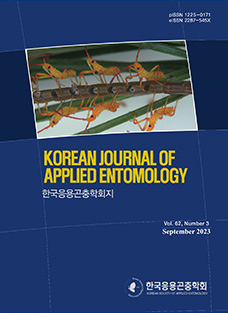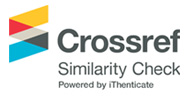Dokdo is a volcanic island located in the East Sea approximately 87.4 km east of Ulleungdo, and 216.8 km from the Korean mainland. The island consists of two main islets, Dongdo (East Island) and Seodo (West Island), as well as 89 smaller islets and rock formations, and is designated as Natural Monument No. 336 of Korea (Cultural Heritage Administration, 2003). With its volcanic origin dating back 4.6 to 2.5 million years (Jeon, 2005), Dokdo presents a distinctive geological and ecological environment among the Korean islands (Kim et al., 2007).
Although biotic surveys in Dokdo have documented vascular plants, birds, marine invertebrates, insects, and microorganisms (Hwang et al., 2023), and several studies have investigated soil properties and soil-dwelling organisms, including microbes and nematodes (Kim et al., 2019;Namirimu et al., 2019;Eo et al., 2022;Lee et al., 2024), soil microarthropods, especially mites, have not been cataloged. Notably, acarological studies have been conducted on nearby Ulleungdo, highlighting the lack of comparable data for Dokdo (Keum and Jung, 2012;Kim et al., 2013;Bayartogtokh and Bae, 2024).
Soil mesofauna, such as mites (Acari) and springtails (Collembola), are abundant in soil ecosystems and are frequently used as bioindicators due to their sensitivity to environmental changes and ease of sampling (Gerlach et al., 2013;George et al., 2017). Among the Acari, the order Mesostigmata contains many predatory mites that contribute to the regulation of other soil invertebrate populations (Gulvik, 2007;George et al., 2017).
The genus Macrocheles Latreille (Mesostigmata: Macrochelidae) is a globally distributed group often found in dung, decaying organic matter, and animal nests, often exhibiting phoresy on insects such as beetles and flies (Evans and Browning, 1956;Emberson, 1973;Krantz and Whitaker, 1988). In Korea, 10 species of Macrocheles have been recorded: M. aviaton Seo, 1966; M. decoloratus (Koch, 1893); M. glaber (Müller, 1860); M. insignitus Berlese, 1918; M. japonicus Evans and Hyatt, 1963; M. muscaedomesticae (Scopoli, 1772); M. nataliaeBregetova and Koroleva, 1960;M. punctatus Ishikawa, 1967; M. scutatiformis Petrova, 1967; and M. similis Krantz and Filipponi, 1964 (Kontschán et al., 2014;Keum et al., 2016;Ji et al., 2023a, 2023b;National Institute of Biological Resources, 2024). Among them, M. aviaton is the only species originally described from the Korean peninsula, based on material from North Korea. However, due to the lack of available specimens and follow-up studies, its current taxonomic status and distribution remain uncertain.
In this study, we report the first record of Macrocheles penicilliger in Korea, found in Dokdo and identified based on both morphological and molecular data. We also discuss its genetic variation and provide comments on its identification, which have implications for future taxonomic and ecological research on phoretic mites inhabiting isolated island ecosystems.
Materials and Methods
Sample collection
Soil samples were collected from both main islands of Dokdo, Dongdo and Seodo, in 2023 and 2024. The samples were taken to a depth of 5 cm below the soil surface. Mites were extracted using a Berlese–Tullgren funnel trap with a 30 W halogen lamp over 72 h (Bano and Roy, 2016), and extracted mites were preserved in a 70% ethanol solution at -20°C. For slide preparation, the mites were cleared in lactophenol and mounted on a glass slide with a drop of Hoyer’s medium (Krantz and Walter, 2009).
Morphological identification
Species identification of the slide-mounted mite specimens was performed using an Olympus BX50 light microscope (Olympus, Japan) and a Keyence VHX digital microscope (Keyence, Japan). Morphological analysis was carried out using the identification keys of Evans and Browning (1956) and idiosomal chaetotaxy system of Lindquist and Evans (1965), as applied to macrochelids by Hyatt and Emberson (1988). All measurements are in micrometers (μm) and based on Keyence VHX digital microscope software. The length and width of the idiosoma were measured along the midline, from the anterior margin to the posterior end, and at the widest point of the body, respectively. The examined specimens were deposited in the National Institute of Biological Resources (NIBR), Korea.
DNA extraction and PCR amplification
The non-mashed method was used for mite DNA extraction (Khaing et al., 2013). A single mite was placed in a 1.5 mL microcentrifuge tube containing 180 μL of genomic digestion buffer and 20 μL of proteinase K solution, both from the PureLink Genomic DNA Mini Kit (Invitrogen, CA, USA). The sample was then heated to 55°C for 12 hours. The exoskeleton was then collected to serve as the voucher specimen, while the remaining solution was processed for DNA extraction according to the PureLink Genomic DNA Mini Kit protocol.
For amplification, PCRs were performed using 30 μL reaction mixtures consisting of 15 μL of Pre-Mix (Solgent, Daejeon, Korea), 2 μL of each primer (10 pmol/μL), 4 μL of DNA extract, and 7 μL of distilled water. The 658 bp mitochondrial cytochrome c oxidase I (COI) nucleotide sequence was targeted using the primer pair LCO1490 (5'-GGT CAA CAA ATC ATA AAG ATA TTG G-3') and HCO2198 (5'-TAA ACT TCA GGG TGA CCA AAA AAT CA-3') (Folmer et al., 1994). The thermocycler protocol included an initial denaturation at 92°C for 5 min, followed by 35 cycles of denaturation at 92°C for 60 s, annealing at 55°C for 60 s, and extension at 72°C for 60 s, with a final extension step at 72°C for 5 min. The PCR products were confirmed by 1% agarose gel electrophoresis using UltraPure™ low melting point (LMP) Agarose (Invitrogen, CA, USA) and subsequently purified.
DNA sequence assembly and phylogenetic analyses
Sequencing was performed at Solgent (Daejeon, Korea) using the BigDye® Terminator v3.1 Cycle Sequencing Kit. The resulting COI sequences were aligned with 16 sequences from 13 species retrieved from the GenBank database of the National Center for Biotechnology Information (NCBI) (Table S1) using the L-INS-i method (Katoh et al., 2005) implemented in MAFFT via the online service (Katoh et al., 2019). Genetic distances within the sequence dataset were calculated based on the p-distance using MEGA X (Kumar et al., 2018). The aligned sequences were analyzed using MrModeltest v2.4 (Nylander, 2004) to determine the optimal substitution model. Based on the Akaike information criterion (AIC), the GTR+I+G model (general time reversible model with a proportion of invariant sites and gamma-distributed rate variation between sites) was selected as the best-fitting model for both maximum likelihood (ML) and Bayesian inference (BI) analyses.
The phylogenetic tree based on the ML method was constructed using the Windows version of IQ-TREE2 v2.3.6 (Minh et al., 2020) with 1,000 bootstrap resamples. The BI analysis was conducted using the Windows version of MrBayes v3.2.7 (Ronquist et al., 2012). The analysis included four Markov chain Monte Carlo (MCMC) chains and two independent runs with 107 generations each, with sampling every 1,000 generations. The first 50% of the generations were discarded as burn-in. Two Glyptholaspis sp. (Macrochelidae) sequences (MN361179 and MN363457) were used as an outgroup.
Results
Systematic accounts
Family Macrochelidae Vitzthum, 1930
Genus Macrocheles Latreille, 1829
Species Macrocheles penicilliger (Berlese, 1904)
Description of the Korean specimens
Female: Dorsal shield 830–850 long and 480–500 wide, with a smooth anterior margin and a serrated posterior margin extending from the lateral edges to the terminal region (Figs. 1A, 2A). Dorsal setae plumose, except for z1, z5, j6, z6, J2, and J5, which are simple (Fig. 2A), with z5 occasionally plumose (Fig. 3). Sternal shield bearing three pairs of sternal setae, with the first pair (st1) distally plumose and the second and third pairs (st2 and st3) simple (Figs. 1B, 2B). Metasternal shields paired, each with one simple seta pair st4 located laterally to the genital shield. Ventri-anal shield 290–300 long and 300– 310 wide, bearing three pairs of pre-anal setae, one pair of para-anal setae, and a single post-anal seta. Pre-anal and para-anal setae simple; post-anal seta short and plumose. No platelet present between the genital and ventrianal shields. One pair of elongate, strongly sclerotized metapodal plates present lateral to the ventrianal shield. Epistome with simple lateral projections and a deeply bifurcated median process (Fig. 1C). Fixed and movable cheliceral digits, each with two denticles; ventral seta elongated and densely pilose. In leg I, tarsus 120– 130 long, longer than tibia, which is about 100.
Material examined: 1♀, soil and litter, Seodo (West Isl.), Dokdo (37°24'06.2"N, 131°86'51.5"E) and 13♀, soil and litter, Dongdo (East Isl.), Dokdo (37°23'88.3"N, 131°86'90.6"E), Ulleung-eup, Ulleung-gun, Gyeongsangbuk-do, Korea, 15. vi. 2023., H. Hwang coll.; 3♀, soil and litter, Dongdo (East Isl.), Dokdo (37°23'88.3"N, 131°86'90.6"E), Ulleung-eup, Ulleunggun, Gyeongsangbuk-do, Korea, 13. viii. 2024., S.-H. Lim coll.
Global distribution: USA, Europe, Australia, New Zealand, India, Africa, Japan (Takaku, 2000), Russia (Bregetova and Koroleva, 1960), China (Lin and Zhang, 2010), Iran (Hajizadeh et al., 2020), Korea.
Molecular analyses
The genetic distanced between the 16 COI sequences from the Dokdo specimens (accession nos. PV188055, PV276880, PV276881, and PV452829–PV452841) were determined (Table 1). The sequence PV188055 was obtained from the mite collected on Seodo, while the other sequences were obtained from mites on Dongdo. There was a sequence dissimilarity of 2.43% (16/658 bp) between PV188055 and the other Dokdo sequences. When the Dokdo mite sequences were compared to 16 publicly available COI sequences from the NCBI GenBank database representing 13 Macrocheles species using the pdistance method (Table 1), the Seodo mite sequence (PV 188055) was 100% identical with four sequences of M. penicilliger from Belgium (accession no. MH983630, MH983673, MH983678, MH983713), registered by Young et al. (2019). In contrast, the other Dokdo sequences (PV276880, PV276881, and PV452829–PV452841) showed 2.43–2.58% dissimilarity with the Belgian sequences. In contrast, interspecific variation between the Dokdo mite sequences and other Macrocheles species ranged from 23% to 27% dissimilarity (Table 1).
Both ML and BI phylogenetic analyses grouped the Seodo mite sequence (PV188055) with the four Belgian sequences in a sing le n ode, w hereas t he D ong do m ite sequences w ere separated from the Belgian sequences (Fig. 4). The Bayesian posterior probability and bootstrap value for the node within the M. penicilliger branch separating these sequences was 1.00 and 100, respectively, indicating a high degree of node stability in both phylogenetic analyses.
Discussion
In this study, we found M. penicilliger in Dokdo, and it is the first report of this species in Korea. Our morphological analysis of the Dokdo specimens revealed minor differences when compared to the redescription of M. penicilliger in Evans and Browning (1956). In our specimens, the first pair of sternal seta (st1) were weakly plumose distally and the second and third setae (st2 and st3) were simple, whereas Evans and Browning (1956) described the first pair of sternal seta as strongly plumose and the second and third pairs of sternal seta as weakly plumose distally. These morphological differences represent genetic variation between populations at the intraspecific level that may be associated with the wide geographic distribution of M. penicilliger (Bregetova and Koroleva, 1960;Takaku, 2000;Lin and Zhang, 2010;Hajizadeh et al., 2020).
In addition, we analyzed the COI sequences of 16 M. penicilliger individuals from Dokdo and found that the COI sequence of the one individual from Seodo, differed in 2.43% of base pairs from the rest of the individuals, which were from Dongdo, suggesting that the individuals from the two main islands of Dokdo are genetically distinct. Interestingly, the COI sequence of the Seodo individual was 100% identical to those reported from Belgium. This suggests that, although this species is distributed worldwide, some groups are genetically quite conservative.
Many species in the genus Macrocheles exhibit phoretic behavior, migrating by attaching themselves to the bodies of various flying insects (Evans and Browning, 1956;Cicolani, 1983;Krantz and Whitaker, 1988). Therefore, it is speculated that M. penicilliger on the Dokdo may have arrived via flying insect vectors originating from other regions. Knee (2017) suggested that the genetic divergence observed in M. willowae was more strongly associated with host specificity to various burying beetles (Coleoptera: Silphidae, Nicrophorus) than with geographic isolation. Although M. penicilliger is typically found in soil or decaying leaf litter, it has also been recorded in bird and small mammal nests and in guano, and has been associated with Trox scaber and T. suguyai (Coleoptera: Trogidae), both of which are burying beetles that often congregate around bird nests (Evans and Browning, 1956;Takaku, 2000). Furthermore, M. penicilliger has been found in the nests of Bombus terrestris (Hymenoptera: Apidae) and Dichotomius carolinus (Coleoptera: Scarabaeidae) (Emberson, 1973;Krantz and Whitaker, 1988).
In addition to insect-mediated dispersal, bird-mediated introduction has also been proposed as a potential pathway for mite colonization of avian nests. Bajerlein et al. (2006) suggested that Mesostigmata mites including M. merdarius found in white stork (Ciconia ciconia) nests may have been introduced either through phoresy on coprophagous beetles or via the incorporation of cow dung by adult storks during nest construction. Similarly, Gwiazdowicz et al. (2006) identified M. glaber, M. merdarius, and other Mesostigmata mites in the nests of the white-tailed sea eagle (Haliaeetus albicilla), and proposed that the presence of mites commonly found in soil and decaying wood could be explained by their passive introduction along with nest-building materials transported by the birds. In the case of M. penicilliger from Dokdo, it is possible that this species was introduced by the black-tailed gull (Larus crassirostris), the island's primary breeding bird. However, these gulls typically construct their nests on bare ground or rocky cliffs using grass-like plants collected from the surrounding area (Lee and Yoo, 2005;Kim et al., 2017). Considering the type of nesting material used, the ecological preference of M. penicilliger for soil and leaf litter habitats, and the geographic isolation of Dokdo, it seems unlikely that M. penicilliger was introduced by black-tailed gulls.
Taken together, the observed presence of genetically distinct populations on Dongdo (East Island) and Seodo (West Island) suggests that the phoretic hosts may have differed, or that multiple independent introductions from different sources occurred. To clarify the origin and dispersal patterns of M. penicilliger on Dokdo, further genetic studies of populations from other geographic regions, as well as targeted investigations of potential phoretic hosts inhabiting the Dokdo, are needed.













 KSAE
KSAE





